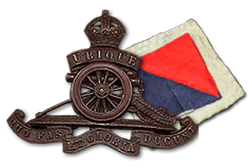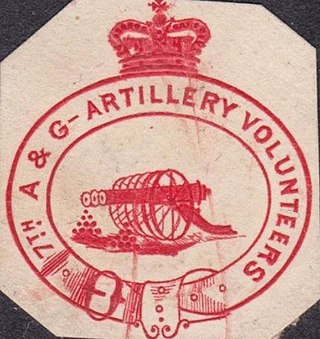
135th Field Regiment was a Royal Artillery (RA) unit being formed in Britain's part-time Territorial Army (TA) on the outbreak of World War II. Spun off from an existing unit, it took over two batteries from Hertfordshire and Northamptonshire and was later granted the double subtitle '(East Anglian) '. As part of the 18th Infantry Division the regiment remained in the United Kingdom until 1941 when it was sent to India. The division was deployed to Fortress Singapore where it was captured by the Japanese. Some of the prisoners were murdered in cold blood, many of the others died working on the Burma Railway. The regiment was never reformed.
The Birmingham Rifles was a volunteer unit of the British Army founded in Birmingham in 1859. As the 5th Battalion, Royal Warwickshire Regiment, it served as infantry on the Western Front and in Italy during World War I. Its successor units served in air defence during the early part of World War II, and later as anti-tank gunners in the Burma Campaign.

The 1st Lincolnshire Artillery Volunteers were formed in 1860 as a response to a French invasion threat. They fought on the Western Front during World War I. In World War II, the unit took part in the Battle of France and Dunkirk evacuation, the Anglo-Iraqi War with 'Kingcol', the Western Desert Campaign in which it distinguished itself at the Battle of Sidi Rezegh, and finally fought as infantry in the Chindits. The unit was disbanded in 1947.
The 1st Lanarkshire Artillery Volunteers were formed in 1859 as a response to a French invasion threat. Its units fought at Gallipoli and in Palestine during World War I, and in Normandy and North West Europe during World War II. It continued in the postwar Territorial Army until 1961.

The 1st Midlothian Artillery Volunteer Corps was formed in 1859 as a response to a French invasion threat. Originally it served as garrison and heavy artillery but transferred to the Territorial Force (TF) in 1908 as field artillery, in which role it served through both World Wars. In the First World War, it fought on the Western Front with 51st (Highland) Division. In the Second World War, it briefly saw service in France after the Dunkirk evacuation and later served with the Eighth Army in North Africa and Italy. Its wartime duplicate regiment served with distinction in the Burma campaign. Postwar, the regiment continued in existence until amalgamation in 1967.

The 2nd Cinque Ports Artillery Volunteers was a part-time unit of the British Army's Royal Artillery from 1890 to 1955. Raised as coastal defence artillery, it later served as field artillery in Mesopotamia during the First World War and in the Battle of France and Second Battle of El Alamein during the Second World War. Its successor units later operated as medium artillery in North West Europe, and as jungle artillery in Burma. Postwar, it became an anti-aircraft unit.

The 101st Heavy Anti-Aircraft Regiment, Royal Artillery was an air defence unit of Britain's Territorial Army raised in northern Scotland just before World War II. After defending the naval base of Scapa Flow against air attack in the early part of the war, the regiment went to India and later took part in the Burma Campaign in the anti-aircraft role and with heavy howitzers in support of ground forces, even on occasion fighting as infantry. It was reformed in the post-war TA and continued until the abolition of Anti-Aircraft Command in 1955.

The 1st Ayrshire and Galloway Artillery Volunteer Corps was formed in 1859 as a response to a French invasion threat. It transferred to the Territorial Force (TF) in 1908 and its successor units fought with the 52nd (Lowland) Infantry Division in Palestine during World War I, and in North West Europe and Burma during World War II. It continued in the Territorial Army (TA) until amalgamation in 1967.

The 115th Field Regiment was a part-time unit of Britain's Royal Artillery (RA), raised as part of the Territorial Army (TA) just before the outbreak of World War II. It served in the Battle of France and the Burma Campaign, and in the postwar TA.

The 4th Lancashire Artillery Volunteers, later renamed to the 4th West Lancashire Brigade, known as 'The Old 4th', was a part-time unit of the British Army's Royal Artillery founded in Liverpool in 1859. It served on the Western Front during World War I, one of its members winning the Victoria Cross at Cambrai. Between the world wars the unit pioneered mechanical traction methods. During World War II it formed three regiments that saw action at Dunkirk, in East Africa, on Crete, at Tobruk, in Burma, and in the final campaigns in Italy and North West Europe. It continued in the post-war Territorial Army until 1973.

79th (Lowland) Field Regiment was a Royal Artillery (RA) unit of Britain's part-time Territorial Army (TA) during World War II. It was descended from the 1st Ayrshire and Galloway Artillery Volunteers, first raised in Scotland in 1859. It served in Home Forces for most of the war, undergoing training in mountain warfare and air-portable operations before eventually going into action at sea level in the Battle of the Scheldt. It then took part in the fighting in the Rhineland, and then the drive to Bremen. It was reformed in the postwar TA, and continued until 1967.

178th Assault Field Regiment, Royal Artillery, was a British Army unit during World War II. Formed as a conventional field artillery regiment in 1942, it was sent to Burma where it was given a range of specialist roles, ranging from operating tracked self-propelled guns to manning light howitzers parachuted into jungle clearings. After the Japanese surrender, it saw action in the Allied Occupation of Java before disbanding in late 1946.

The 8th London (Howitzer) Brigade, Royal Field Artillery was a new unit formed when Britain's Territorial Force was created in 1908. Its origin lay in Artillery Volunteer Corps formed in the 1860s in Plumstead, Kent, later incorporated into London. Together with its wartime duplicate the brigade served during the First World War on the Western Front, at Salonika and in Palestine where it was the first British unit to enter Jerusalem. It again formed two units for service in the Second World War, one of which saw extensive action in France, North Africa, and Italy, while its duplicate was captured at the Fall of Singapore. Its successor unit continues in the Army Reserve today.

The 51st Field Regiment, was a Royal Artillery unit of Britain's part-time Territorial Army (TA) formed after World War I from a Yeomanry Cavalry regiment recruited in Cumbria. One of its batteries served in the Norwegian campaign at the beginning of World War II. The regiment then sailed to the Middle East and took part in the Western Desert campaign, including the Siege of Tobruk and Operation Crusader. It was next transferred to Ceylon and later formed a Chindit column in the Burma Campaign. The regiment continued in the postwar TA until 1961.

The Manchester Artillery is a Volunteer unit of the British Army first raised in the City of Manchester in 1860, whose successors continue to serve in the Army Reserve today. It became a brigade of the Royal Field Artillery in the Territorial Force in 1908, and in World War I it served in Egypt in 1915–17 before being broken up. Its second line unit went to the Western Front in 1917, seeing action at Ypres, against the German Spring Offensive, and leading the pursuit in the Allies' victorious Hundred Days Offensive. Just before World War II the Manchester Artillery again formed a duplicate. While the parent regiment served in the Battle of France including the Dunkirk evacuation, and later in the Middle East and the Italian campaign, its duplicate fought in Normandy and North West Europe. Both regiments were reformed postwar, but after a number of amalgamations they and several other Manchester-based units were reduced into 209 Battery in the present-day Army Reserve.

52nd (Manchester) Field Regiment was a Royal Artillery (RA) unit of Britain's part-time Territorial Army (TA) during World War II. It was descended from the Manchester Artillery, first formed in the City of Manchester in 1860. It served in the Battle of France, at the end of which its personnel were evacuated from Dunkirk. It was then sent to the Middle East where it joined 8th Indian Division and fought with this division in the Italian Campaign. It was reformed in the postwar TA, and its successor unit continues as a battery in the present day Army Reserve

The Bolton Artillery, under various titles, has been a Volunteer unit of the British Army based in Bolton, Lancashire, since 1889. In the First World War it served in Egypt and Gallipoli in 1915–17, and then on the Western Front for the rest of the war, including Passchendaele, the German Spring Offensive and the Allied Hundred Days Offensive. Just before the outbreak of the Second World War the regiment formed a duplicate unit. The parent regiment served in the Battle of France and was evacuated from Dunkirk. Both regiments served at the Battle of Alamein and in the Italian campaign, while one of the regiments was involved in the intervention in Yugoslavia. The regiment was reformed postwar, and after a number of mergers its successors continue to serve in today's Army Reserve.

111th (Bolton) Field Regiment was a Royal Artillery (RA) unit of Britain's part-time Territorial Army (TA) formed just before World War II. It was descended from the Bolton Artillery, first formed in the Lancashire town of Bolton in 1889. After serving in home defence it was sent to the Middle East where it participated in the Second Battle of El Alamein and the Battle of Mareth. It served in the Italian Campaign, and was then transferred to Yugoslavia, fighting alongside Tito's Partisans. The regiment was disbanded at the end of the war.
The 1st Worcestershire Artillery Volunteers was a part-time unit of Britain's Royal Artillery dating back to 1865. As part of the Territorial Force it served on the Western Front and in Italy during World War I. In World War II it served in the Battle of France and was evacuated from Dunkirk. It later fought in Tunisia and Italy. After a series of postwar mergers, it continues as a battery in today's British Army Reserve.

The 1st Warwickshire Volunteer Artillery, or 'Balsall Heath Artillery', was a part-time unit of Britain's Royal Artillery recruited from Birmingham. It served on the Western Front during the First World War, including the Battles of the Somme, Vimy Ridge, Messines, Ypres, the German Spring Offensive and the final victorious Hundred Days Offensive. During the Second World War it fought in the Battle of France and was evacuated from Dunkirk. Later in served in the Italian campaign. It continued in the postwar Territorial Army, through a series of mergers, until 1971.














